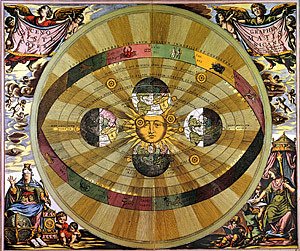Let’s suppose you’re doing last Sunday’s crossword puzzle.
You’re stumped on seven down: a five-letter word for “indistinct”. There are a couple of possibilities here, but the one that pops into your mind first is “fuzzy”, so you drop that in, very faintly, in pencil.
Okay, now what? Fifteen across, a six-letter word for “mystery”, is now coming up “enizma”, which is obviously wrong. A moment’s thought gives us a 99.9% certainty that we should be seeing “enigma” in that slot, but that gives us “fugzy” for seven down, our original problem clue: once again, it’s safe to assume that something’s not clicking.
What to do? It doesn’t take a rocket scientist to see that “fuzzy” isn’t working, so out comes the thesaurus.
Let’s see: “Blurry”? That gives us “enirma”, and we’re not having any of that. “Indefinite”? Too many letters. “Soft”? Too few.
Here we go: “Vague”. Pencil it in, and … yes! It fits. We fill in a few of the blanks around it and we see that everything works.
*
The scientific method is like that crossword puzzle. There are some things you’re positive about, some you’re reasonably sure you’ve figured out correctly, and some you just can’t quite pin down, but the important thing is that everything interconnects, so a piece of the puzzle that’s clearly wrong will begin to stand out pretty quickly as the rest of the clues are filled in.
Individual facts, like the words in the crossword, can be tried, rejected, accepted, or replaced, but what matters in the end is the internal consistency of the entire structure, and the way the whole puzzle evolves and solidifies as more and more blanks are filled in. “Fuzzy” was perfectly acceptable until “enizma” came along; then it became clear that there was an error somewhere, because the bigger pattern wasn’t holding together.
Until Nicolaus Copernicus overturned the applecart in the sixteenth century, the generally accepted view of the solar system placed the earth at the center, with the sun, moon and planets orbiting around it. This system worked fine for centuries, but as time passed and the observed data began to fill in more and more blanks, problems appeared. To make the system fit what we could actually see happening in the sky, the orbits of all the heavenly bodies had to be incredibly complex. Mars and Jupiter needed to stop dead and then go backward from time to time; eclipses could only be explained by mysterious invisible objects casting shadows at odd angles; the moons of Jupiter and Saturn had to perform amazing spirals and loop-the-loops.
All the blanks in the crossword had words in them, but the answers weren’t making any sense.
Copernicus looked at the problem and realized that maybe “fuzzy” wasn’t the right word for seven down (figuratively speaking). He made a very simple adjustment in the prevailing system: he moved the sun into the center, and the planets into orbit around it, with their own moons orbiting them in turn. Now, suddenly, all of the orbits were ordinary ellipses, smooth and steady; eclipses were nothing more than shadows cast by one object on another; and the positions of all the bodies could be predicted centuries in advance by calculations any educated person could understand. It was no longer necessary to accept “enizma” as a word.
“Those who know that the consensus of many centuries has sanctioned the conception that the earth remains at rest in the middle of the heavens as its center, would, I reflected, regard it as an insane pronouncement if I made the opposite assertion that the earth moves.”
Nicolaus Copernicus
Even Copernicus didn’t have all the answers. With the passage of time, we’ve developed more sophisticated tools with which to observe our universe, and we’ve found questions that would have crippled the thinkers of the Renaissance. In the sixteenth century no one was equipped to measure the gravitational interactions between and among the planets; we didn’t know anything about how spacetime itself was organized, or the subtle effects of solar cycles and nearby stars on planetary orbits; the very size and shape of the universe could only be guessed at.
But still, even today, we can build on what Copernicus gave us all those years ago: we don’t have to try to come up with some elaborate excuse to allow us to use “enizma” for fifteen across. We can use logic and common sense to resolve the dilemma, and from there we can move on to new questions, and search for better answers to old ones.
In religion, no one questions the unreasonable answer or the wildly complicated explanation. We just accept that “enizma” is correct, even if it doesn’t seem to make the least bit of sense, because that’s what faith is: accepting without the need to understand.
The fundamental truth of science, on the other hand, is that there are no fundamental truths: we observe, we theorize, we experiment, and when we find a model that works, we build from there, knowing that it’s best to use a pencil, because we may still have to go back and change an early answer based on what we’ve learned since.
And that, dear reader, is why I love science. An enigma is a challenge to be met, a question for which each new answer always leads to bigger and more exciting puzzles demanding to be solved — and if we’re willing to stop at “enizma”, we’ll never have the opportunity.
* * *

Leave a Reply